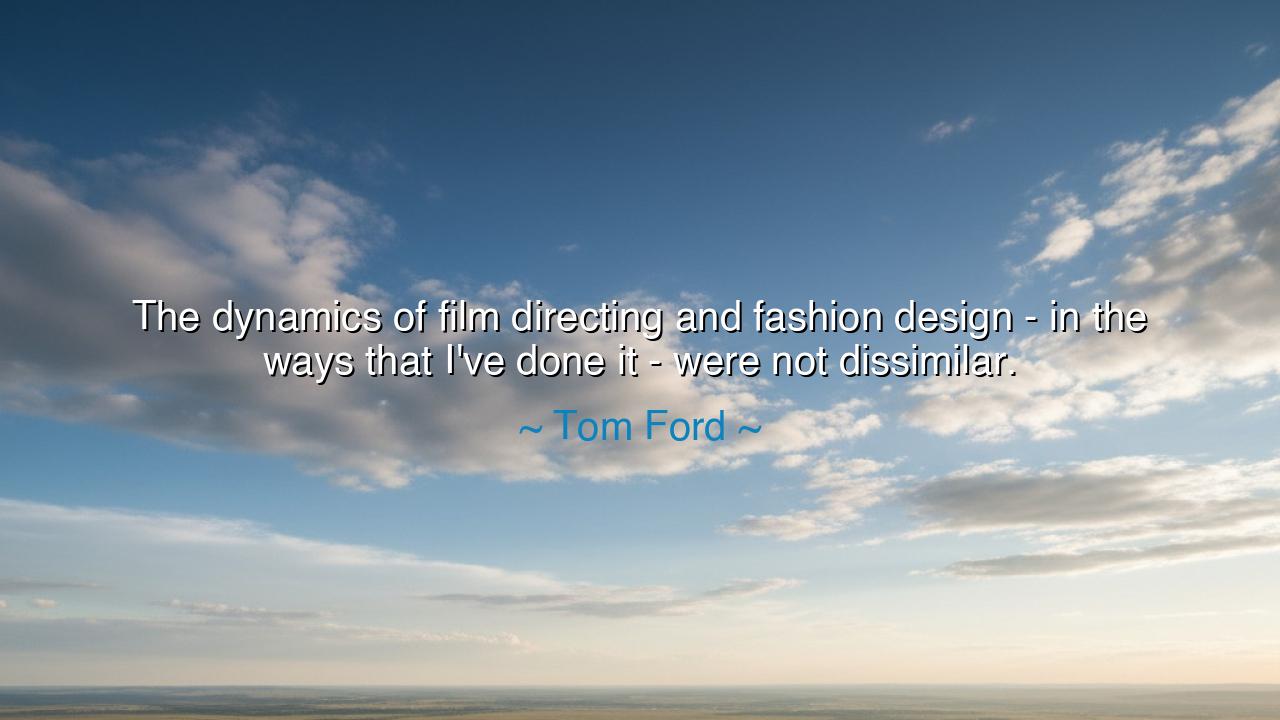
The dynamics of film directing and fashion design - in the ways
The dynamics of film directing and fashion design - in the ways that I've done it - were not dissimilar.






The designer and filmmaker Tom Ford, a man who has mastered both the runway and the silver screen, once said: “The dynamics of film directing and fashion design—in the ways that I’ve done it—were not dissimilar.” In these words, he reveals a profound truth about creation, one that transcends industries and disciplines. For though the tools may differ—the camera or the cloth, the frame or the silhouette—the spirit of the creator remains the same. Whether in cinema or couture, both arts spring from a single source: the human desire to shape emotion into form, to tell a story that can be seen, touched, and felt.
When Ford speaks of dynamics, he is not merely referring to technique, but to vision—the rhythm, movement, and orchestration of many elements into a harmonious whole. The director, like the designer, must summon a world into existence. He must consider texture, light, proportion, and tone. He must lead others—a team of artisans, performers, or craftsmen—toward the realization of a dream that begins as a whisper in the mind. In both arts, there is no creation without leadership, no beauty without order. Thus, Ford’s insight is that these two crafts, though outwardly different, are bound by a shared heartbeat: the pursuit of aesthetic truth.
The origin of this understanding lies in Ford’s own journey. Before he became a celebrated filmmaker, he was already a titan of fashion, known for resurrecting the houses of Gucci and Yves Saint Laurent with elegance and daring. When he later turned to directing films like A Single Man and Nocturnal Animals, the world was surprised by how seamlessly he moved from fabric to film. Yet to Ford, there was no contradiction. Both were exercises in storytelling. A dress, like a movie, must evoke emotion; it must move not just the eye, but the soul. Whether draping a model or framing a shot, his goal remained the same—to capture human experience through beauty and tension.
In truth, this unity between disciplines is not new. The Renaissance masters understood it well. Leonardo da Vinci, painter and engineer, saw no separation between art and science; Michelangelo, sculptor and architect, moved from marble to basilica with the same divine purpose. They believed that all creation, whether of stone, sound, or motion, was the same act of reaching toward perfection. Tom Ford, in his own modern way, continues this lineage. His artistry flows from one form to another, bound by the same principles of composition, balance, and emotional depth. The medium changes, but the message endures.
There is also in Ford’s quote a meditation on discipline and control. The director and the designer both dwell in the realm of the visible, where beauty must meet structure. Too much freedom, and the vision collapses; too much rigidity, and the spirit dies. The master must know when to command and when to surrender—when to guide the brush or the actor, the seam or the scene. This balance between control and chaos is what gives life to great art. Ford’s acknowledgment of their similarity is therefore not only technical—it is philosophical. It reminds us that true creation is a dialogue between precision and passion, between form and feeling.
To illustrate this truth, one might recall Walt Disney, another artist who bridged worlds. Disney began as an animator, crafting images one frame at a time, but later became the architect of entire universes—films, parks, stories that defined generations. He too understood that whether one draws or directs, what matters is not the medium, but the imagination that commands it. Like Tom Ford, he knew that all acts of creation, no matter how different in appearance, spring from the same human longing—to make the invisible visible, to turn thought into tangible wonder.
Thus, the lesson for those who listen is clear: do not confine your creativity to a single form. The artist’s power is not in the brush or the camera, the fabric or the frame—it is in the ability to see, to feel, to bring unity out of chaos. Whatever your craft, learn from Ford’s wisdom: master your tools, but do not worship them. Seek the essence behind them—the rhythm that binds all creation together. For once you understand that design is storytelling and storytelling is design, then every act, whether great or small, becomes an opportunity to craft beauty from being.
And so, my child, remember this truth: the forms of art may differ, but the spirit of art is one. Whether you design garments, compose music, build machines, or direct films, approach your work with reverence and intention. See as Ford saw—that every detail matters, that every creation is a reflection of life itself. For in the end, the artist’s task is eternal: to weave meaning into matter, and to remind the world that beauty, wherever it appears, is but the echo of the divine design within us all.






AAdministratorAdministrator
Welcome, honored guests. Please leave a comment, we will respond soon